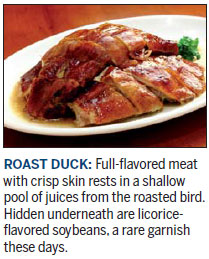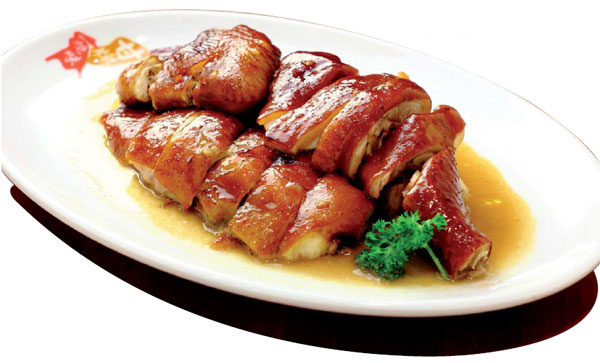Timeless Chinese BBQ

Editor's note: To understand China, sit down to eat. Food is the indestructible bond that holds the whole social fabric together and it is also one of the last strong visages of community and culture.
In virtually any Chinatown in the world, barbecued duck, chicken and pork are a standard sight, hanging on hooks behind glass counters - effective advertising to attract meat lovers of all nationalities. It works like magic.
Unexpected guests for dinner? Run down to the Chinese barbecue and get a roast duck. The chef will even chop it up for you, ready to go on the plate once you reach home. Or ask for a mixed platter for a savory variety.
Solitary and hungry for lunch or dinner? Rice and noodles are staples, topped by your choice of meat, from a roast duck drumstick to maybe a row of neatly slivered barbecued pork loin. The barbecue chef will even throw in a salad of cucumber, cilantro, tomato, and pickled radishes and carrots.
| Soy sauce chicken is made from organic chicken that is repeatedly dunked into a boiling soy sauce marinade until the bird is just cooked and still slightly pink at the bone. Photos by To Chee Kan / For China Daily |
| The perfect bowl of won-ton noodles must have egg noodles cooked al dente and dumplings that float like clouds in the tasty soup. |
Such is the universal appeal of Chinese barbecue worldwide that it is often the first introduction to Chinese food, followed probably by dim sum, the snacks-on-trolleys at Chinatown restaurants.
We owe this to the first emigrants from southern China, the Cantonese, whose legacy was further reinforced later by a second diaspora of chefs from Hong Kong in the mid-1990s.
It's still the Hong Kong chefs who do barbecue best, having the advantage of a sophisticated, appreciative audience and access to the best ingredients. Where else would you find them making char siew from the best Kurobuta pork?
Let's take a tour of the Chinese barbecue counter.
First there will be several kind of birds hanging whole, ready to be cut up and served as orders come in. There will be whole roast geese, distinguishable from ducks by their longer necks, larger bodies and a fatty hump at the top of their heads.
There are ducks, of course, skins crisp and burnished a beautiful red-bronze by a maltose glaze, slow roasting over an open fire. Often, there are whole chickens - braised, not roasted, and succulent at every bite, their skin saturated by a fragrant soy sauce marinade kicked up a notch by Chinese rice wine.
Whole slabs of belly pork are salted, seasoned with five-spice powder and roasted until their skins puff up. The siew yuk or shaorou is a delicious masterpiece with distinct layers of lean meat and fat topped by an exquisite square of crisp crackling.
Char siew is the name for honeyed strips of barbecued pork fillets, which are often the most popular.
Whereas the roast duck, the braised soy chicken and even the crackling-topped belly pork are pretty specific in their use of ingredients, barbecue chefs in Hong Kong and Guangdong have exercised the most creativity in making char siew.
Traditionally, the recipe calls for a loin fillet that is marinated in a thick soybean paste, maltose or honey-and-soy sauce. The strips of meat are then hung and baked in a drum oven until the fatty edges crisp or even blacken. The burnt ends are very popular with children.
Modern-day chefs are catering to changing tastes.

At one time, pale pink and generously marbled pork cheeks were used to make char siew. The result was an incredibly tender piece of meat that almost melts in the mouth. This is still my favorite cut of meat.
The trend these days is to offer two types of char siew, a fatty version and a healthier alternative. The fatty char siew is made with meat just bordering the belly, with enough marbling to ensure tenderness and some visible fat on the edges that crisp up for a flavor contrast.
Perhaps this is a knee-jerk reaction to the health fads that have cut a swath across the food and beverage industry.
Chinese barbecue is also famous for its accompanying sauces and garnishes. For roast goose and duck, there is always a hot, dark chili oil and a sweet-and-sour thick plum sauce, both designed to cut the grease. In the past, every order of roasted bird came with a shallow pool of duck or goose juices and several spoonfuls of candied whole soybeans braised in licorice bark and soy sauce.
The soy-braised chicken, however, comes with a sauce of pulverized spring onions and ginger scalded in sesame oil.
Salads of sliced cucumbers and tomatoes, pickled radishes and carrots are all part of the mise-en-place. And, you can order rice or noodles to go with your barbecue, always with a thoughtful ladle of sauce drizzled over them.
Restaurant dishes follow trends and consumer fads, but if ever there is an evergreen, it must be the time-tested Chinese barbecue.
paulined@chinadaily.com.cn
Grassroots favorites earn Michelin stars 
When the famed Michelin Guide to good food first entered China, it zoomed in on Hong Kong, where food is a major attraction for both tourists and locals. It also wisely took to the streets instead of confining its critiques to posh restaurants.
So it was that a hole-in-the-wall dim sum shop got its one Michelin star, and a Chinese barbecue stall run by three generations of chefs was awarded another.
The dim sum outfit is Tim Ho Wan, and the Chinese barbecue is Kam's Roasts - both of which have been successfully franchised and exported to other countries, such as Singapore.
The master franchisee is none other than Robert Chua, the legendary broadcaster who turned the Chinese variety show Enjoy Yourself Tonight into a launchpad for countless Hong Kong television celebrities. 
In his second career as he tops 70, Robert Chua is powering his way forward in the food and beverage industry. Television and food are not much different, he says. They are both people industries.
"You must give them a good product, honest hard work and thoughtful service," he says.
Needless to say, you also need an excellent entrepreneurial sense and people skills to persuade the owners of Tim Ho Wan and Kam's Roasts to hand over the franchises.
When we visited his restaurant, Chua did not say much but he was certainly doing a lot.
As Kam's executive chef, Wong Kwan Seng, says, Chua is a tireless dynamo, personally overseeing the staff, greeting customers, introducing the menu and even clearing the tables after the diners have finished.
Seven decades old, he still sets an example that shames those much younger. And that's why I have no doubt that a Kam's Roasts will soon come to a location near you.
(China Daily Africa Weekly 12/30/2016 page19)
Today's Top News
- Foreign ministers of China, Egypt call for Gaza progress
- Shield machine achieves Yangtze tunnel milestone
- Expanding domestic demand a strategic move to sustain high-quality development
- Xi hears report from Macao SAR chief executive
- Xi hears report from HKSAR chief executive
- UN envoy calls on Japan to retract Taiwan comments
































